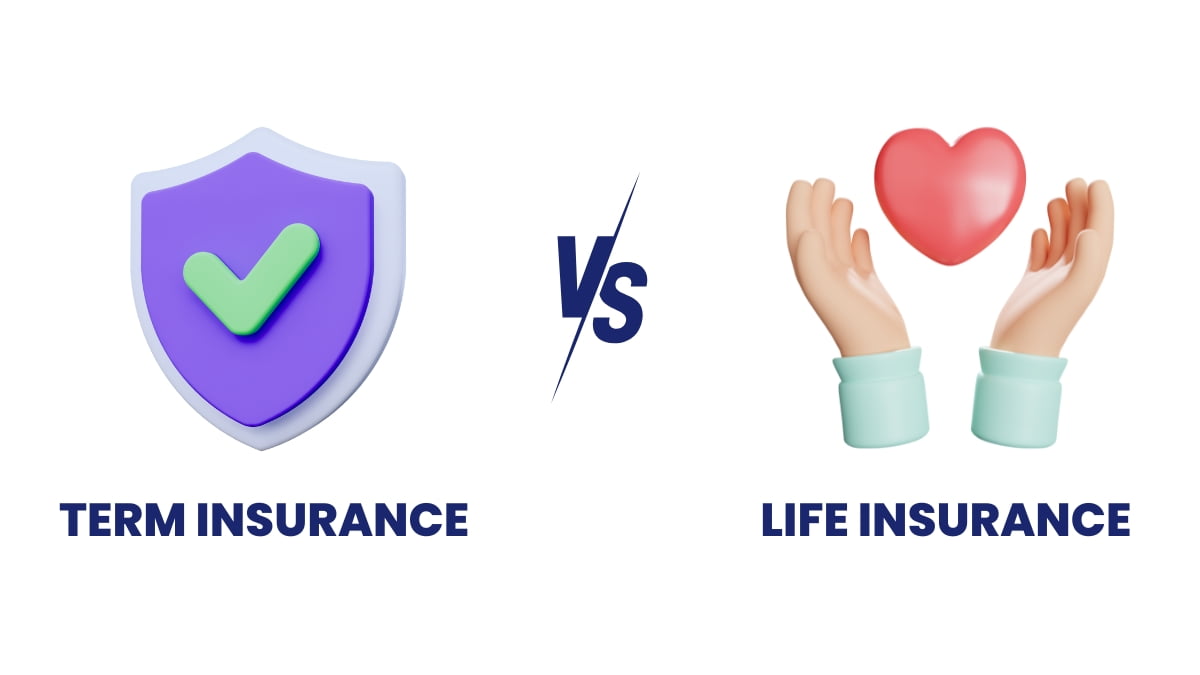Introduction
Choosing between term insurance and whole life insurance can be challenging, as both offer unique benefits and serve different purposes. Understanding the key differences between these types of insurance is essential for making an informed decision that aligns with your financial goals and needs. This blog will compare term insurance and whole life insurance to help you determine which one is right for you.

Understanding Term Insurance
Term insurance provides coverage for a specified period or “term,” such as 10, 20, or 30 years. It offers financial protection to your beneficiaries if you pass away during the term. If you outlive the policy term, there is no payout, and the coverage ends unless you renew the policy or convert it to a permanent policy. Term insurance remains affordable because it provides only a death benefit and excludes an investment component.
Understanding Whole Life Insurance
Whole life insurance, or permanent life insurance, covers you for your entire life, provided you continue to pay the premiums. In addition to the death benefit, whole life insurance includes a cash value component that grows over time. This cash value can be borrowed against or withdrawn, providing a source of funds for various financial needs. Whole life insurance premiums are higher than those of term insurance due to the lifelong coverage and cash value accumulation.
Cost Comparison
One of the most significant differences between term and whole life insurance is the cost. Term insurance premiums are generally lower, making it an attractive option for individuals seeking substantial coverage at an affordable price. This affordability is particularly beneficial for young families or those with limited budgets who need to ensure financial protection for a specific period.
In contrast, whole life insurance premiums are higher because they cover the policyholder for their entire life and include a savings component. While the higher cost may be justified by the lifelong coverage and cash value, it may not be feasible for everyone, especially those on a tight budget.
Coverage Duration
Term insurance is ideal for those who need coverage for a specific period, such as until their children are financially independent or their mortgage is paid off. The temporary nature of term insurance makes it suitable for covering time-bound financial obligations.
Whole life insurance, on the other hand, provides lifelong coverage, making it a good choice for individuals who want to ensure their beneficiaries receive a death benefit regardless of when they pass away. This lifelong coverage can be beneficial for estate planning, providing funds to cover estate taxes or leaving a financial legacy.
Cash Value Component
A significant advantage of whole life insurance is its cash value component. As you pay premiums, a portion is allocated to the cash value, which grows tax-deferred over time. This cash value can be accessed through loans or withdrawals, providing a flexible financial resource for emergencies, retirement, or other financial needs.
Term insurance does not have a cash value component, focusing solely on providing a death benefit. While this makes term insurance more affordable, it does not offer the same savings or investment benefits as whole life insurance.
Flexibility
Term insurance offers flexibility in choosing coverage periods that match your financial needs. You can select a term length that aligns with specific life stages or financial goals, such as covering the years until your children graduate from college or until your mortgage is paid off. Some term policies also offer the option to convert to a permanent policy without a medical exam, providing a pathway to lifelong coverage if your needs change.
Whole life insurance, while less flexible in terms of adjusting coverage periods, offers stability with lifelong coverage. The fixed premiums and guaranteed death benefit provide certainty and can be a cornerstone of long-term financial planning.
Investment Component
Whole life insurance acts as both an insurance policy and an investment vehicle. The cash value component grows at a guaranteed rate, and some policies may pay dividends, providing additional growth potential. This investment aspect can be attractive for those looking to build wealth while securing lifelong coverage.
Term insurance does not include an investment component, focusing purely on providing death benefit protection. This simplicity can be an advantage for individuals who prefer to separate their insurance and investment strategies, investing their money elsewhere for potentially higher returns.
Conclusion
Whole life insurance, with its lifelong coverage and cash value component, is suitable for those who want to ensure their beneficiaries receive a death benefit no matter when they pass away and who value the investment aspect of the policy. Its higher cost may be justified by the added benefits of cash value accumulation and potential dividend payments.
Choosing between term insurance and whole insurance depends on your financial goals, budget, and coverage needs. Term insurance is an excellent choice for those seeking affordable, temporary coverage to protect their loved ones during specific life stages. Its low premiums and flexibility in choosing coverage periods make it a practical option for many individuals.
Ultimately, the decision between term and whole life insurance should be based on a thorough evaluation of your financial situation and long-term goals. Consulting with an insurance advisor can provide personalized insights and help you choose the policy that best meets your needs.

